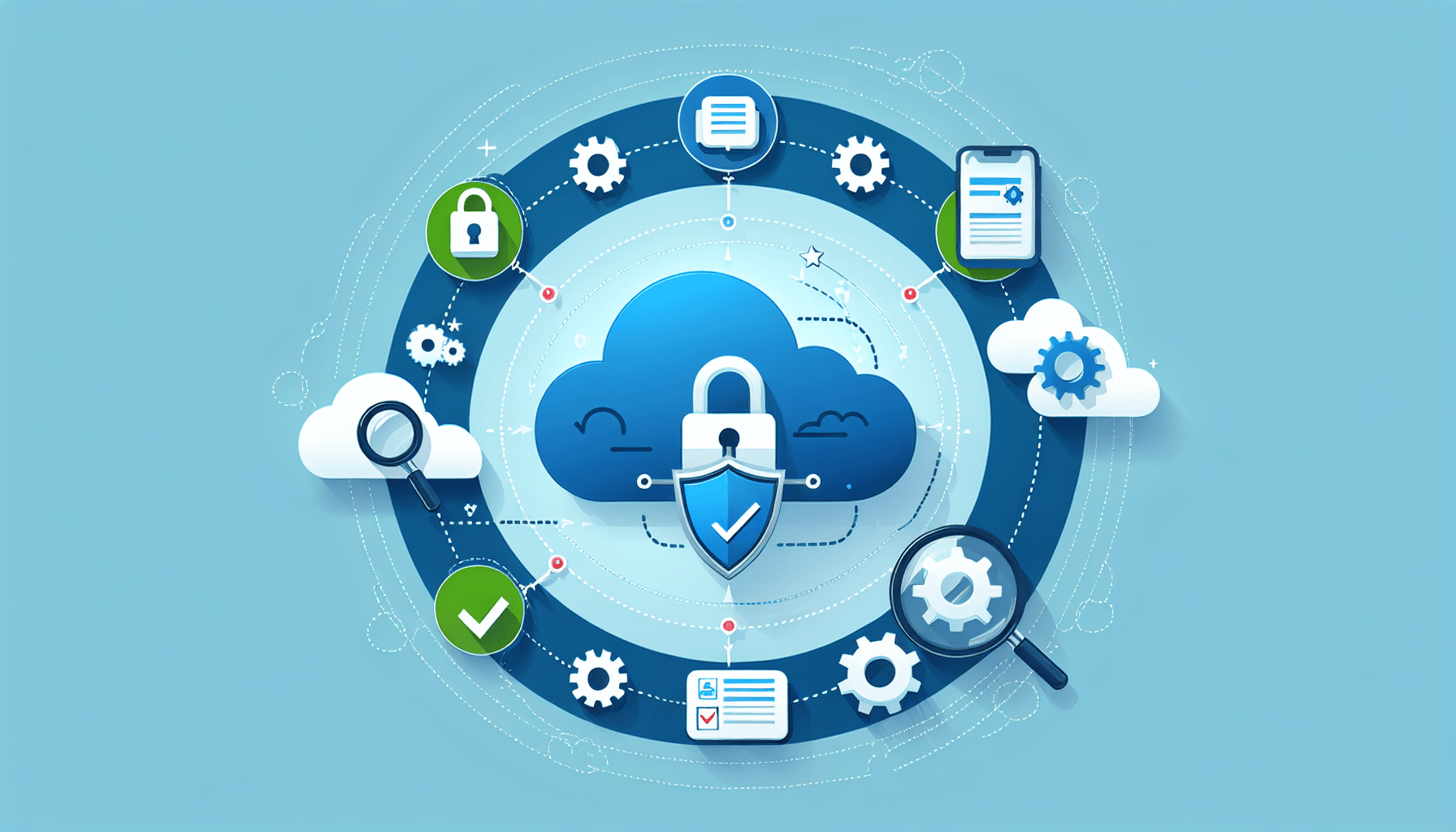Data privacy is a critical concern when it comes to cloud security assessments. As organizations increasingly rely on cloud services to store and process sensitive data, it becomes imperative to ensure that this information is protected from unauthorized access or misuse. In order to address this, rigorous protocols and procedures must be put in place to assess and verify the security of cloud systems. This article explores the importance of data privacy in cloud security assessments and provides insights into the measures that organizations can take to safeguard their sensitive information in the cloud.
1. Importance of Data Privacy in Cloud Security Assessments
In today’s digital age, where data is becoming increasingly valuable and targeted by cybercriminals, ensuring data privacy in cloud security assessments is of utmost importance. With the proliferation of cloud computing, organizations are storing and processing vast amounts of sensitive information in the cloud, necessitating robust measures to protect this data.
1.1 Protecting Sensitive Information
Data privacy is crucial as it involves safeguarding sensitive information from unauthorized access, use, or disclosure. In cloud security assessments, organizations must prioritize the protection of personal and confidential data, such as personally identifiable information (PII), financial records, health records, or trade secrets. Breaches of this information can result in severe financial, legal, and reputational consequences for organizations, making data privacy an essential aspect of cloud security assessments.
1.2 Regulatory Compliance
Meeting regulatory compliance requirements is another critical reason why data privacy is essential in cloud security assessments. Various industry-specific regulations, such as the General Data Protection Regulation (GDPR), the California Consumer Privacy Act (CCPA), and the Health Insurance Portability and Accountability Act (HIPAA), impose strict obligations on organizations to protect the privacy and security of data. Failure to comply with these regulations can lead to hefty fines, legal actions, and damaged relationships with customers and partners. By prioritizing data privacy in cloud security assessments, organizations can ensure compliance with relevant regulations and avoid potential penalties.
1.3 Building Trust with Customers
Data privacy plays a pivotal role in building and maintaining trust with customers. In an era of frequent data breaches and privacy concerns, customers are becoming increasingly cautious about sharing their personal information with organizations. By demonstrating a commitment to data privacy through robust cloud security assessments, organizations can instill confidence in their customers and differentiate themselves from competitors. Building trust in data privacy practices can lead to increased customer loyalty, positive brand reputation, and business growth opportunities.
2. Challenges in Ensuring Data Privacy
While data privacy is crucial, there are several challenges organizations face when ensuring it in cloud security assessments.
2.1 Data Breaches
Data breaches are a significant challenge to data privacy in cloud security assessments. As cyber threats continue to grow in sophistication, organizations must stay vigilant and proactively protect their data from unauthorized access. A single data breach can expose sensitive information, result in financial losses, and erode customer trust. Organizations must implement robust security controls and regularly assess their cloud infrastructure to detect and mitigate vulnerabilities that could lead to data breaches.
2.2 Lack of Control and Visibility
The cloud environment introduces complexities that can make maintaining data privacy challenging. While organizations may outsource their data storage and processing to cloud service providers (CSPs), they still bear the responsibility of ensuring data privacy. However, organizations often have limited control and visibility into the data protection practices of CSPs. This lack of control can hinder organizations’ ability to assess and monitor data privacy effectively. Organizations must establish strong contractual agreements with CSPs, outlining specific data privacy requirements and conducting regular audits to ensure compliance.
2.3 Data Governance
Organizations face the challenge of establishing and maintaining effective data governance frameworks to protect data privacy in cloud security assessments. Data governance encompasses policies, procedures, and controls that govern how data is collected, stored, accessed, and used. In the cloud environment, where data may be distributed across multiple locations and accessed by various stakeholders, maintaining consistent and comprehensive data governance becomes more challenging. Organizations must establish clear data governance frameworks that define roles, responsibilities, and accountability for data privacy, ensuring compliance with applicable regulations and internal policies.

3. Best Practices for Data Privacy in Cloud Security Assessments
To mitigate the challenges and ensure data privacy in cloud security assessments, organizations should adopt best practices. These practices promote a secure and privacy-centric approach to managing data in the cloud.
3.1 Strong Access Controls and Authentication Mechanisms
Implementing robust access controls and authentication mechanisms is critical for protecting data privacy in cloud security assessments. Organizations should enforce strong password policies, multi-factor authentication, and role-based access controls to ensure that only authorized individuals can access sensitive data. Additionally, regular access reviews and auditing help identify and address any potential security gaps.
3.2 Encryption and Data Masking
Encrypting sensitive data and employing data masking techniques are essential practices for data privacy in cloud security assessments. Encryption transforms data into an unreadable format, protecting it from unauthorized access. Data masking involves disguising sensitive information with fictional or altered data, preserving its format while rendering it useless to unauthorized individuals. By applying encryption and data masking techniques, organizations can protect data even if it falls into the wrong hands.
3.3 Regular Data Backup and Recovery Processes
Regularly backing up data and establishing robust recovery processes are vital for data privacy in cloud security assessments. Data loss can occur due to various reasons, including accidental deletion, system failures, or cyberattacks. By implementing comprehensive backup strategies and performing routine backups, organizations can ensure data availability and recoverability in the event of data loss or corruption, thus maintaining data privacy.
3.4 Privacy Impact Assessments
Conducting privacy impact assessments before deploying cloud solutions is an effective practice for ensuring data privacy. Privacy impact assessments help organizations identify and address potential privacy risks associated with the collection, use, and storage of personal data in the cloud. By assessing the impact of their cloud solutions on data privacy, organizations can implement necessary controls and mitigation strategies to protect sensitive information.
3.5 Employee Training and Awareness Programs
Educating and training employees on data privacy best practices is essential for securing data in cloud security assessments. Employees play a significant role in safeguarding data and must understand their responsibilities and the potential risks associated with mishandling sensitive information. Regular training and awareness programs help foster a culture of security and privacy consciousness within the organization, reducing the likelihood of data breaches or privacy incidents.
4. Compliance with Data Privacy Regulations
Compliance with data privacy regulations is a crucial aspect of cloud security assessments. Organizations must familiarize themselves with relevant regulations and implement necessary controls to ensure compliance.
4.1 General Data Protection Regulation (GDPR)
GDPR is a comprehensive privacy regulation that sets stringent requirements for organizations handling the personal data of European Union (EU) citizens. Organizations subject to GDPR must implement measures such as obtaining explicit consent for data processing, implementing privacy by design, and ensuring timely breach notifications. Compliance with GDPR is essential for organizations operating in the EU or handling EU citizen data, and failure to comply can result in substantial penalties.
4.2 California Consumer Privacy Act (CCPA)
CCPA is a state-level regulation that grants California residents specific privacy rights and imposes obligations on organizations processing their personal information. Organizations subject to CCPA must provide clear disclosures regarding data collection and usage, offer opt-out mechanisms, and ensure the security of personal information. Compliance with CCPA is essential for organizations doing business in California and handling Californian residents’ data.
4.3 Health Insurance Portability and Accountability Act (HIPAA)
HIPAA is a U.S. federal regulation that governs the security and privacy of protected health information (PHI). Organizations in the healthcare industry must comply with HIPAA by implementing safeguards to protect PHI, ensuring secure transmission of data, conducting regular risk assessments, and maintaining proper data retention and disposal practices. Compliance with HIPAA is critical for organizations handling PHI to avoid legal and reputational consequences.

5. Securing Data in Transit and at Rest
Securing data both in transit and at rest is vital to maintain data privacy in cloud security assessments. Organizations must employ strong encryption and other protective measures to safeguard data throughout its lifecycle.
5.1 Transport Layer Security (TLS) and Secure Sockets Layer (SSL)
Transport Layer Security (TLS) and Secure Sockets Layer (SSL) protocols provide secure communication channels by encrypting data transmitted over networks. Organizations should ensure that all data transfers between systems in the cloud are protected using TLS or SSL, preventing unauthorized interception or tampering of data.
5.2 Data Encryption at Rest
Data encryption at rest involves encrypting data stored in databases, file systems, or other data storage components. Organizations must leverage industry-standard encryption algorithms and key management practices to protect data at rest. Encryption ensures that even if unauthorized individuals gain access to the data storage infrastructure, they cannot decipher the encrypted data.
5.3 Data Loss Prevention (DLP) Solutions
Data Loss Prevention (DLP) solutions play a crucial role in securing data in transit and at rest. These solutions help organizations detect and prevent the unauthorized transmission or exfiltration of sensitive data. By employing DLP solutions, organizations can enforce data protection policies, monitor data usage, and prevent data leakage, thereby improving data privacy in cloud security assessments.
6. Data Privacy Audits and Certifications
Conducting data privacy audits and obtaining relevant certifications demonstrate an organization’s commitment to data privacy in cloud security assessments. These audits and certifications provide independent validation of an organization’s data privacy practices and enhance its credibility.
6.1 SSAE 16 Type II (SOC 2) Compliance
Statement on Standards for Attestation Engagements No. 16 (SSAE 16) Type II compliance ensures that an organization has implemented adequate controls and safeguards to protect sensitive data. SOC 2 reports evaluate an organization’s security, availability, processing integrity, confidentiality, and privacy controls. Achieving SOC 2 compliance demonstrates an organization’s commitment to data privacy and provides customers and stakeholders with assurance regarding the security and privacy of their data.
6.2 ISO 27001 Certification
ISO 27001 is an internationally recognized information security management system standard. By obtaining ISO 27001 certification, organizations demonstrate their commitment to protecting the confidentiality, integrity, and availability of information. ISO 27001 certification requires organizations to establish a comprehensive set of controls, including controls related to data privacy, to ensure the security of their information assets.
6.3 Payment Card Industry Data Security Standard (PCI DSS)
Organizations handling payment card data must comply with the Payment Card Industry Data Security Standard (PCI DSS). PCI DSS ensures the secure handling of cardholder data, protecting it from breaches and unauthorized access. Compliance with PCI DSS involves implementing a wide range of security controls, including encryption, access controls, and regular security assessments. Achieving PCI DSS compliance demonstrates an organization’s commitment to protecting sensitive payment card data, thereby enhancing data privacy in cloud security assessments.
7. Collaboration and Accountability in Cloud Security
Collaboration and accountability are pivotal aspects of ensuring data privacy in cloud security assessments. Organizations must work closely with their cloud service providers and establish clear accountability measures to protect data.
7.1 Shared Responsibility Model
The shared responsibility model defines the division of responsibilities between organizations and cloud service providers. While CSPs are responsible for the security of the cloud infrastructure, organizations bear the responsibility of securing their data and applications within the cloud. By understanding and fulfilling their respective responsibilities, organizations and CSPs can collaborate effectively and maintain data privacy in cloud security assessments.
7.2 Service Level Agreements (SLAs)
Clear and well-defined Service Level Agreements (SLAs) help establish accountability and ensure data privacy in cloud security assessments. SLAs should outline specific data protection requirements, including security controls, incident response procedures, and data breach notification obligations. Regular monitoring and enforcing of SLAs help organizations hold their cloud service providers accountable for maintaining data privacy.
7.3 Incident Response and Notification
Establishing robust incident response and notification processes is vital for prompt actions in the event of a data breach or privacy incident. Organizations should have documented incident response plans that outline the steps to be taken in case of a security breach, including containment, investigation, and notification procedures. By promptly responding to incidents and notifying affected parties, organizations can mitigate the impact of data breaches and demonstrate their commitment to data privacy.
8. Monitoring and Logging for Data Privacy
Comprehensive monitoring and logging mechanisms are essential for maintaining data privacy in cloud security assessments. These mechanisms enable organizations to detect and respond to security incidents, detect anomalies, and ensure compliance with data protection requirements.
8.1 Log Management and Analysis
Effectively managing and analyzing logs generated by cloud infrastructure and applications is crucial for detecting and investigating security incidents. Organizations should implement centralized log management solutions to collect, store, and analyze log data. By monitoring and analyzing logs for suspicious activities or unauthorized access attempts, organizations can proactively identify potential data privacy risks and take appropriate actions.
8.2 Intrusion Detection and Prevention Systems (IDPS)
Intrusion Detection and Prevention Systems (IDPS) continuously monitor network traffic and system activities to detect and prevent unauthorized access attempts or malicious activities. By deploying IDPS in the cloud environment, organizations can detect and respond to potential data privacy breaches in real-time, enhancing the overall security posture and data privacy in cloud security assessments.
8.3 Continuous Security Monitoring
Continuous security monitoring involves regularly monitoring the cloud infrastructure, applications, and data to identify potential security incidents or vulnerabilities. Continuous monitoring helps organizations detect and respond to security events, such as unauthorized access, data breaches, or malicious activities, in a timely manner. By continuously monitoring their cloud environment, organizations can maintain data privacy and ensure the ongoing effectiveness of their security controls.
9. Data Privacy in Multi-Cloud Environments
With the increasing adoption of multi-cloud environments, ensuring data privacy poses unique challenges. Organizations must adopt specific strategies to address these challenges effectively.
9.1 Data Governance and Centralized Control
In multi-cloud environments, organizations should establish robust data governance frameworks and centralized control mechanisms to maintain data privacy. Clear data governance policies and procedures help organizations govern how data is collected, stored, accessed, and used across multiple cloud platforms. Centralized control mechanisms, such as unified identity and access management solutions, enable organizations to enforce consistent access controls and monitor data privacy across multiple cloud environments.
9.2 Interoperability and Data Portability
Interoperability and data portability are critical considerations in multi-cloud environments for maintaining data privacy. Organizations should ensure that data can be securely transferred and accessed across different cloud platforms, without compromising its privacy or security. Standardized data formats, encryption practices, and secure data transfer mechanisms help organizations achieve interoperability while maintaining data privacy in multi-cloud environments.
9.3 Vendor Management and Due Diligence
Effective vendor management and due diligence are essential for data privacy in multi-cloud environments. Organizations should thoroughly assess the privacy and security practices of cloud service providers before engaging their services. By conducting comprehensive vendor risk assessments, reviewing contracts, and performing regular audits, organizations can ensure that their cloud service providers adhere to data privacy standards and protect sensitive information.
10. Evolving Threat Landscape and Emerging Technologies for Data Privacy
As the threat landscape evolves, organizations must leverage emerging technologies to enhance data privacy in cloud security assessments.
10.1 Artificial Intelligence and Machine Learning
Artificial intelligence (AI) and machine learning (ML) technologies can play a significant role in identifying and mitigating data privacy risks. These technologies can analyze large datasets and identify patterns or anomalies that may indicate potential data breaches or privacy incidents. Implementing AI and ML-based solutions, such as anomaly detection algorithms or automated security incident response systems, can help organizations proactively address data privacy issues.
10.2 Blockchain Technology
Blockchain technology offers promising opportunities for enhancing data privacy in cloud security assessments. Blockchain’s decentralized and immutable nature enables secure and transparent data storage and sharing. By leveraging blockchain technology, organizations can enhance the integrity and privacy of data in the cloud, ensuring confidentiality while allowing for verifiability and transparency.
10.3 Zero-Trust Architecture
Zero-Trust Architecture (ZTA) is an approach that incorporates strict access control and authentication measures to protect data privacy. In this model, every device and user is treated as potentially untrusted, requiring continuous authentication and authorization to access resources. Implementing a Zero-Trust Architecture helps organizations minimize the risk of unauthorized access to sensitive data, enhance data privacy, and strengthen overall cloud security assessments.
In conclusion, ensuring data privacy in cloud security assessments is crucial for protecting sensitive information, complying with regulations, and building trust with customers. Organizations must address challenges related to data breaches, lack of control and visibility, and data governance by adopting best practices such as strong access controls, encryption, regular backups, privacy impact assessments, and employee training programs. Compliance with regulations such as GDPR, CCPA, and HIPAA is essential, along with securing data in transit and at rest through protocols like TLS and data loss prevention solutions. Conducting audits, obtaining certifications, and focusing on collaboration, accountability, and monitoring further enhance data privacy. With the emergence of multi-cloud environments, organizations should prioritize data governance, interoperability, and vendor management. Embracing emerging technologies like AI, blockchain, and Zero-Trust Architecture can further bolster data privacy in cloud security assessments. By implementing these comprehensive measures, organizations can ensure the privacy and security of their data in the cloud and mitigate potential risks.



